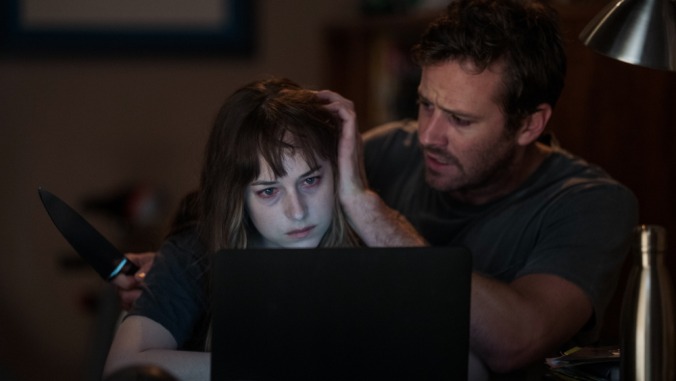Wounds wants to sell you a cursed smartphone, but the service sucks


The horror genre loves awful humans, the kind of arrogant, self-obsessed meat puppets that simply demand to be tormented and terrified for the audience’s pleasure. Armie Hammer plays such a barely animated mannequin in Wounds, Babak Anvari’s long-delayed follow-up to 2016’s clever ghost story Under The Shadow. Hammer’s character, Will, is an empty vessel, no more than an updated model of the jerkwad boyfriend in every ’80s slasher. (Y’know, the one whose wealthy family owns the lake house.) He’s wildly overconfident, deeply insecure, and profoundly selfish. By all rights, Will is overdue for comeuppance when a bedeviled cellphone falls into his possession. That moment of reckoning proves too little and comes far too late in Wounds, which barely inflicts any harm on Will or the audience save for a bunch of half-explored ideas and a battalion of cockroaches.
Hammer’s approachable heartthrob physicality makes him an excellent choice to play Will, who has been coasting on looks and practiced charm since dropping out of college. These days he’s a lazy bartender, all too happy to man the nozzles at Rosie’s, a novelistic New Orleans dive where naked denizens drink for free. He’s usually as drunk as the customers, and generally sleepwalks through his responsibilities, only lurching to life at every opportunity to flirt with Alicia (Zazie Beetz), who frequents Rosie’s with her aloof boyfriend, Jeffrey (Karl Glusman). When Will isn’t tuning out during his shifts, he’s stumbling drunk through a peaceful but passionless relationship with his live-in girlfriend, Carrie (Dakota Johnson).
On an otherwise unremarkable night at Rosie’s, some kids shuffle in, use a clearly fake ID to order a round of beers, and end up capturing a brutal bar fight between a volatile regular and a loudmouth wielding a broken beer bottle. The kids’ passive documentation at first suggests a generational indifference to anything that can be turned into social media content. A far more disturbing explanation emerges when one of them leaves behind a phone, one enclosed in a bright yellow case with heart stickers that belie the horror it represents.
Rather than chuck the phone into the nearest lost-and-found bin, Will takes it home and keeps it at arm’s length, the first in a series of inexplicable horror-movie decisions made in the absence of much real duress. Sure, a few alarming text messages pop up, and any reasonable person would be horrified by the video clips in which disembodied heads do the darnedest things. But as cursed objects go, this generic Android device isn’t remotely foreboding. Perhaps the real threat is whoever appears to be watching Will and Carrie, an idea Anvari belabors with waggling handheld shots. Carrie’s rapidly deteriorating psyche is also far from ideal, a result of her efforts to research a mystical book seen in the background of the phone’s disturbing videos. Will isn’t nearly as interested in the device’s provenance, but he too spirals out of control as mysterious rashes appear on his body and roaches become increasingly assertive around him.
Rather than commit to any of these ideas, Wounds tosses them around like macabre confetti, and nothing lands with any real impact. Anvari’s screenplay slavishly replicates its source material, the Nathan Ballingrud novella The Visible Filth. On the page, Will’s descent into phone-induced madness is a brisk and nasty bit of pulp that uses body horror to flirt with ideas about renegade spirituality. The story must have proved irresistible to Anvari, who artfully blended internecine warfare and demonic possession in his sturdy debut. But he’s far too deferential to Ballingrud’s bare-bones text, which used Will’s inner monologue to center his emotions and explain his odder choices.
Anvari’s only advantage is being able to show the supernatural snuff stored on the phone, and even those are more effective as text. The cast does what it can to elevate the material, but only Johnson manages to find the silhouette of an actual character. There’s some solid, if workmanlike, sound design, including a score that mostly sounds like the din of an oscillating fan. But the only time Wounds outmatches its inspiration is in the final scene, which is among the wackiest, most grotesque horror sequences to emerge in 2019. It’s a shame the audience has to wait the entire runtime to see what, in a better film, would have been an inciting event rather than a last-minute stinger.